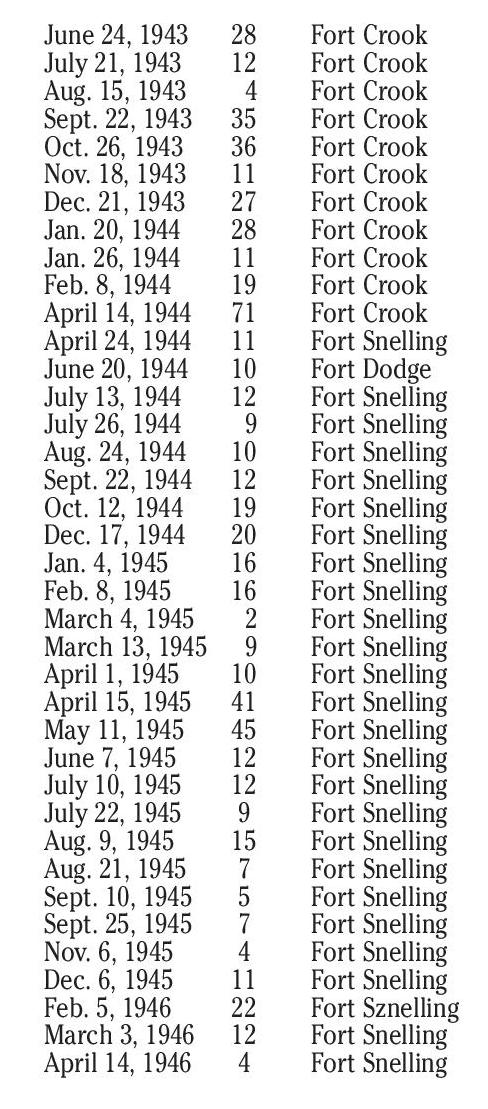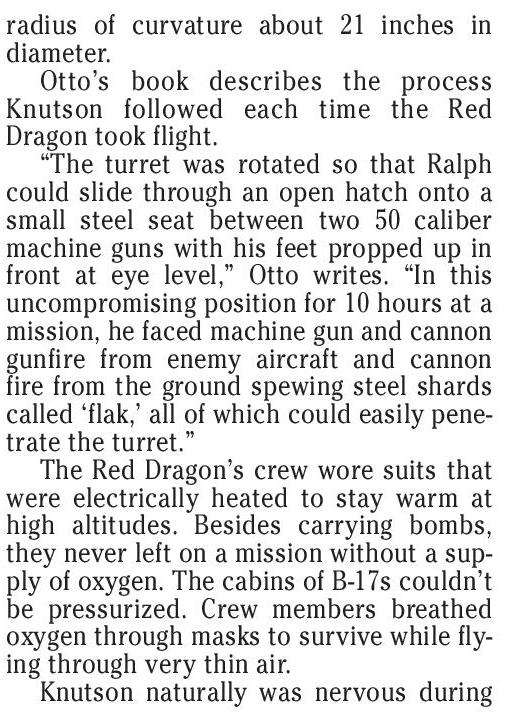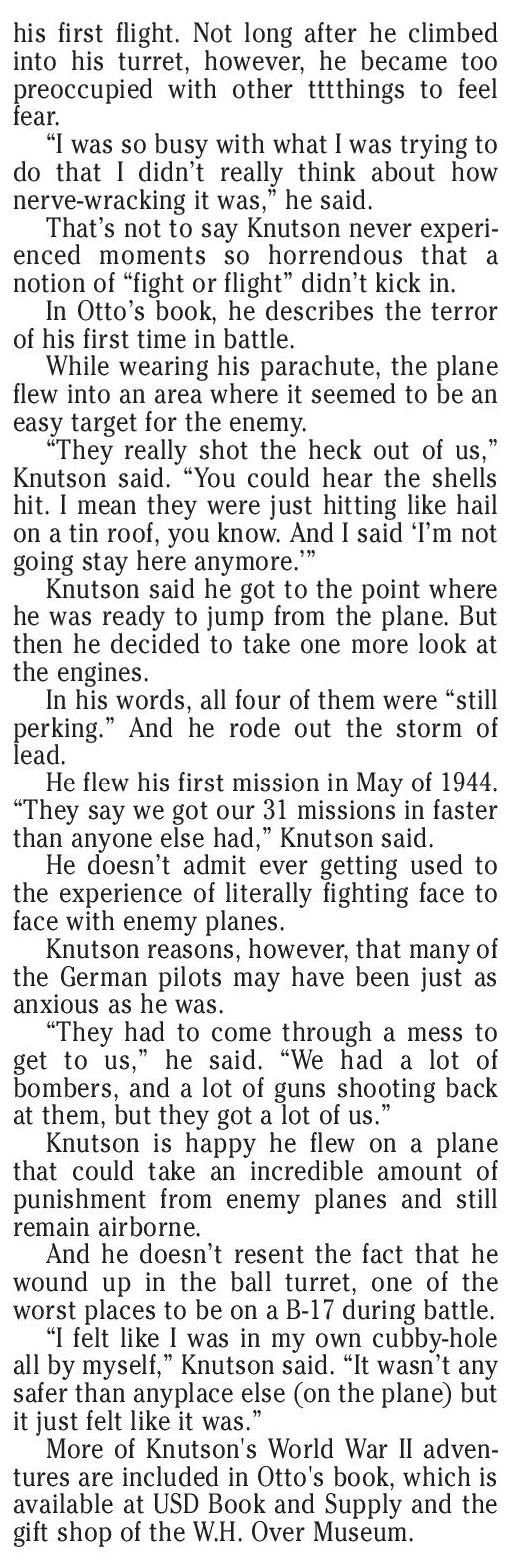6





06 Heritage 2012: Military
November 9, 2012 www.plaintalk.net
Local men stepped up
to answer WWII’s call
BY TRAVIS GULBRANDSON
travis.gulbrandson@plaintalk.net
EXPECT EXCELLENCE
We’re not satisfied until you are!
•Carpet Cleaning
•Tile & Grout Cleaning
•Upholstery Cleaning
•Fire Restoration •Duct
Cleaning • Water
Restoration •Mold
Testing & Remediation
FREE ESTIMATES
(call for details)
Bruce Tirrel
Certified Master Restorer
and Textile Cleaner
We Work With All
Insurance Companies
www.steamwaysrestoration.com
YANKTON 665-5700
VERMILLION 624-4666
Toll Free
1-800-529-2450
One of the areas of interest in the Austin
Whittemore House’s Simonson scrapbook is
that pertaining to recruitment.
Over the course of the war years, the
Vermillion Plain Talk and the Dakota
Republican both printed notices for area
men to get their pre-induction physicals –
the majority of which took place at either
Fort Crook in Nebraska, Fort Dodge in Iowa
and Fort Snelling in Minnesota.
Many of the men whose names were printed in these notices were from the
Vermillion/Yankton area, but the Pacific
states appear on a fairly regular basis, as
well.
On Sept. 24, 1942, Lester Lloyd, secretary
of the selective service board in Clay
County, said he could not give an accurate
count of how many area men were in the
service, but that there were “more than 500.”
The numbers of men called ebbed and
flowed over the years, and were not necessarily indicative of how many were inducted
following the physicals.
But, the numbers did decrease as the war
continued – even while more men were
always needed.
On Jan. 11, 1945, it was reported that local
selective service boards in South Dakota
received a director calling all registrants
ages 18-25 that had been deferred in Class 11C, which pertained to agriculture.
“The further deferment of all men now
deferred in the 18 through 25 age group
because of agricultural occupation is not
essential to the best interest of our war effort
as is the urgent need of the army and navy
for young man,” President Franklin D.
Roosevelt was quoted as saying.
Col. E.A. Beckwith, state director of selective service, said local boards would begin at
once to carry out these directives.
“Our policy has been changed definitely
by the president’s determination,” he said.
“We must now call the under-26-year-olds
except under the most extreme circumstances.”
Up to that point, approximately 364,000
men in the United States had farm deferments, 11,000 of whom were in South Dakota.
Following are the statistics the scrapbook
records, organized by the date the men were
called, the number of men who were called,
and the location to which they had to report:
July 28, 1942
Aug. 24, 1942
Sept. 23, 1942
Oct. 28, 1942
Nov. 21, 1942
Jan. 20, 1943
Feb. 21, 1943
March 3, 1943
March 11, 1943
April 29, 1943
May 21, 1943
June 7-8, 1943
22
18
30
47
35
13
8
19
45
8
33
16
Fort Crook
Fort Crook
Fort Crook
Fort Crook
Fort Crook
Fort Crook
Fort Dodge
Fort Crook
Fort Snelling
Fort Crook
Omaha
Fort Snelling
June 24, 1943
July 21, 1943
Aug. 15, 1943
Sept. 22, 1943
Oct. 26, 1943
Nov. 18, 1943
Dec. 21, 1943
Jan. 20, 1944
Jan. 26, 1944
Feb. 8, 1944
April 14, 1944
April 24, 1944
June 20, 1944
July 13, 1944
July 26, 1944
Aug. 24, 1944
Sept. 22, 1944
Oct. 12, 1944
Dec. 17, 1944
Jan. 4, 1945
Feb. 8, 1945
March 4, 1945
March 13, 1945
April 1, 1945
April 15, 1945
May 11, 1945
June 7, 1945
July 10, 1945
July 22, 1945
Aug. 9, 1945
Aug. 21, 1945
Sept. 10, 1945
Sept. 25, 1945
Nov. 6, 1945
Dec. 6, 1945
Feb. 5, 1946
March 3, 1946
April 14, 1946
28
12
4
35
36
11
27
28
11
19
71
11
10
12
9
10
12
19
20
16
16
2
9
10
41
45
12
12
9
15
7
5
7
4
11
22
12
4
Fort Crook
Fort Crook
Fort Crook
Fort Crook
Fort Crook
Fort Crook
Fort Crook
Fort Crook
Fort Crook
Fort Crook
Fort Crook
Fort Snelling
Fort Dodge
Fort Snelling
Fort Snelling
Fort Snelling
Fort Snelling
Fort Snelling
Fort Snelling
Fort Snelling
Fort Snelling
Fort Snelling
Fort Snelling
Fort Snelling
Fort Snelling
Fort Snelling
Fort Snelling
Fort Snelling
Fort Snelling
Fort Snelling
Fort Snelling
Fort Snelling
Fort Snelling
Fort Snelling
Fort Snelling
Fort Sznelling
Fort Snelling
Fort Snelling
? RED DRAGON
From Page 02
radius of curvature about 21 inches in
diameter.
Otto’s book describes the process
Knutson followed each time the Red
Dragon took flight.
“The turret was rotated so that Ralph
could slide through an open hatch onto a
small steel seat between two 50 caliber
machine guns with his feet propped up in
front at eye level,” Otto writes. “In this
uncompromising position for 10 hours at a
mission, he faced machine gun and cannon
gunfire from enemy aircraft and cannon
fire from the ground spewing steel shards
called ‘flak,’ all of which could easily penetrate the turret.”
The Red Dragon’s crew wore suits that
were electrically heated to stay warm at
high altitudes. Besides carrying bombs,
they never left on a mission without a supply of oxygen. The cabins of B-17s couldn’t
be pressurized. Crew members breathed
oxygen through masks to survive while flying through very thin air.
Knutson naturally was nervous during
his first flight. Not long after he climbed
into his turret, however, he became too
preoccupied with other tttthings to feel
fear.
“I was so busy with what I was trying to
do that I didn’t really think about how
nerve-wracking it was,” he said.
That’s not to say Knutson never experienced moments so horrendous that a
notion of “fight or flight” didn’t kick in.
In Otto’s book, he describes the terror
of his first time in battle.
While wearing his parachute, the plane
flew into an area where it seemed to be an
easy target for the enemy.
“They really shot the heck out of us,”
Knutson said. “You could hear the shells
hit. I mean they were just hitting like hail
on a tin roof, you know. And I said ‘I’m not
going stay here anymore.’”
Knutson said he got to the point where
he was ready to jump from the plane. But
then he decided to take one more look at
the engines.
In his words, all four of them were “still
perking.” And he rode out the storm of
lead.
He flew his first mission in May of 1944.
“They say we got our 31 missions in faster
than anyone else had,” Knutson said.
He doesn’t admit ever getting used to
the experience of literally fighting face to
face with enemy planes.
Knutson reasons, however, that many of
the German pilots may have been just as
anxious as he was.
“They had to come through a mess to
get to us,” he said. “We had a lot of
bombers, and a lot of guns shooting back
at them, but they got a lot of us.”
Knutson is happy he flew on a plane
that could take an incredible amount of
punishment from enemy planes and still
remain airborne.
And he doesn’t resent the fact that he
wound up in the ball turret, one of the
worst places to be on a B-17 during battle.
“I felt like I was in my own cubby-hole
all by myself,” Knutson said. “It wasn’t any
safer than anyplace else (on the plane) but
it just felt like it was.”
More of Knutson's World War II adventures are included in Otto's book, which is
available at USD Book and Supply and the
gift shop of the W.H. Over Museum.


















 Previous Page
Previous Page






